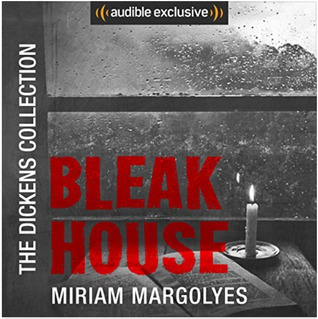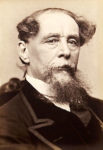 Bleak House by Charles Dickens
Bleak House by Charles Dickens Narrator: Miriam Margolyes
Published by Audible Studios on April 17, 2018 (first published 1853)
Source: Purchased
Genres: Classic
Length: 43 hrs 12 mins
Format: Audiobook
Purchase at Bookshop.org or Purchase at Amazon
Add on Goodreads

Bleak House opens in the twilight of foggy London, where fog grips the city most densely in the Court of Chancery. The obscure case of Jarndyce and Jarndyce, in which an inheritance is gradually devoured by legal costs, the romance of Esther Summerson and the secrets of her origin, the sleuthing of Detective Inspector Bucket and the fate of Jo the crossing-sweeper, these are some of the lives Dickens invokes to portray London society, rich and poor, as no other novelist has done. Bleak House, in its atmosphere, symbolism and magnificent bleak comedy, is often regarded as the best of Dickens. A 'great Victorian novel', it is so inventive in its competing plots and styles that it eludes interpretation.
Bleak House is like a soap opera, in a good way. It was originally written as a serial, so it had to have qualities that kept you coming back, day after day or week after week. There’s murder and romance and everything in between. You’ve got some plot lines that are the same no matter how many months (years) between the last time you watched it. Here it’s the case of Jarndyce and Jarndyce, the longest-running case in the Court of Chancery. This book actually spurred on legal reform in England. There are probably 60-ish characters, some that show up on an irregular basis and play their bit: a dance instructor, a man who constantly lives off others’ generosity, a devoted housekeeper; and others who are the core characters. Bleak House shows us all the types of people in England, the poor, the destitute, the rich, the lawyers and law enforcement, the sick, the lonely.
The central character is Esther Summerson, who we eventually find out is the illegitimate daughter of Lady Dedlock. In due course, Esther comes under the benevolent guardianship of John Jarndyce, a generous and well-meaning man who is an unwilling party to the notorious Chancery case. He provides for Esther’s education and in due course she moves in to live in his home, Bleak House in St. Albans, a place quite the opposite of what its name suggests. Jarndyce also becomes the legal guardian of Richard Carstone and Ada Clare, distant cousins who are wards of the Chancery Court. Richard becomes obsessed with expectations of wealth from the Chancery case, while Ada is Esther’s dearest friend in the world.
All the characters in the novel have some relationship to Esther and, at least tangentially to the Jarndyce and Jarndyce case. Different plots intersect and characters from every aspect of society are entangled. Some moments made me cry, some made me laugh.
Bleak House is such a full, rich novel. Is it overly long? Yes, but so is the Jarndyce and Jarndyce case. It’s a place and time to get lost in. It also makes you think about how the poor are treated today, how young unwed mothers can still be ostracized, how the court does not deal fairly with everyone.
I listened to the audio and Miriam Margolyes did a fabulous job. In her introduction, she talks a little about how she loves Bleak House and about Dickens and she makes it truly accessible. She manages to make each character unique and treats the story like a story. She isn’t overly dramatic, but she never seemed bored either. Just an excellent job – and for a 40+ hour long audiobook, the narrator need to be first class.
Bleak House is only the second Dickens I’ve read, the other being A Christmas Carol, which almost doesn’t count. I always assumed they’d be long and depressing. Yes, this one’s long, but there’s enough story to fill it. And Esther got her happy ending, which is a must for me. Now the question is, do I read more of Dickens’ novels or stop here with the one many people consider his best?

I honestly have read so little by Dickens.
This is only my second. They’re all so daunting.
I can’t remember the last time I read something by Dickens.
Amber read A Tale of Two Cities a couple of years ago and didn’t think I’d like it.
Congrats!
I finally started A Better Man last night, but I’m not very far yet.
[…] House (adventuresofcoops) (Brona) (Carol) (Fanda) (J. E. Fountain) (hillarypat) (Jane) (jeanlp) (Jennygirl) (Melissa) […]